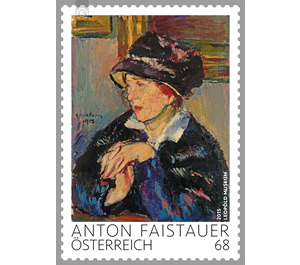Old Masters - Austria / II. Republic of Austria 2015 - 68 Euro Cent
Theme: Art & Culture
| Country | Austria / II. Republic of Austria |
| Issue Date | 2015 |
| Face Value | 68.00 |
| Edition Issued | 300,000 |
| Printing Type | offset |
| Stamp Type | Commemorative |
| Item Type | Stamp |
| Chronological Issue Number | 2561 |
| Chronological Chapter | OOS-OE2 |
| SID | 147724 |
| In 69 Wishlists | |
Born on February 14, 1887 in St. Martin near Lofer, the son of a peasant family, Anton Faistauer founded - together with Felix Harta and several other intellectuals - the artist association "Der Wassermann", which protested against the traditional art business in Vienna the episode also joined a few writers. In the course of the establishment of the Salzburg Festival in 1920, however, the group lost in influence. In the twenties Faistauer created some large frescoes - so he designed, among other things, in 1923 the ceiling frescoes of the Salzburg parish church Morzg and 1926 the famous murals in the foyer of the Salzburg Festival Hall. In 1923 he published his art-theoretical work "Neue Malerei in Österreich. Reflections of a painter ", in which he critically dealt with the painting of his time; In 1926 he was honorary appointed professor. Anton Faistauer died after many years of health problems on February 13, 1930 in Vienna and was buried in Maishofen, where he had lived for a long time. Anton Faistauer did not try to change art radically, but to develop it further and to merge traditional with modern elements. He rejected the decorative art of the Wiener Werkstätte and the artists around Gustav Klimt and found his own expressive style with strong colors and clear forms. The works of Paul Cézanne had a strong influence on his artistic development. Faistauer painted numerous portraits and landscapes and also dealt intensively with religious themes, his wall and ceiling frescoes are today considered to be his most outstanding works. The original of the oil painting "Lady with a dark hat" on the new stamp is part of the valuable collection of the renowned Vienna Leopold Museum.


